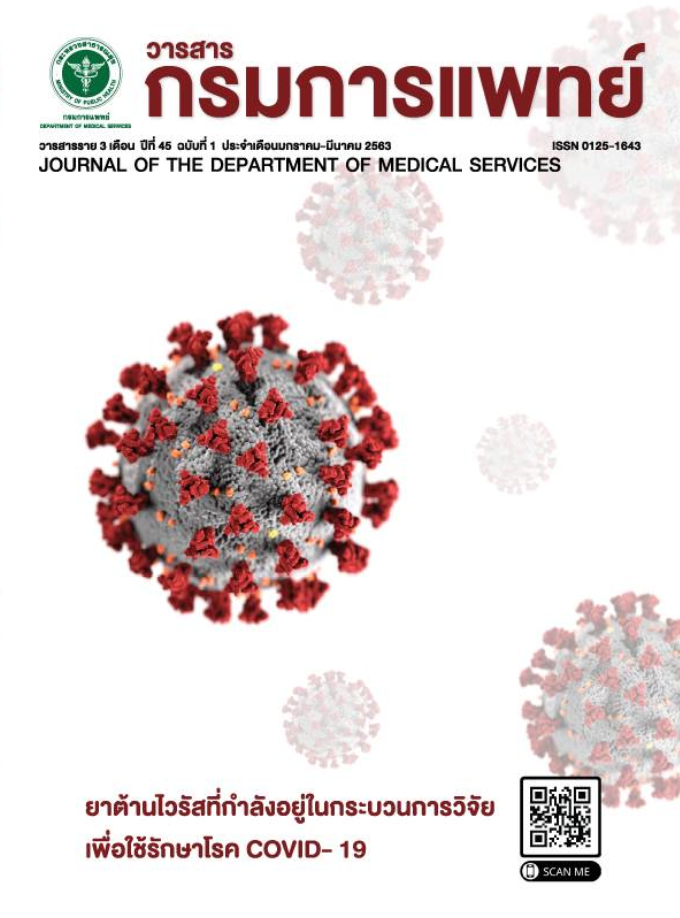Prevalence of Psychiatric Disorders in Inpatients Cannabis Dependents at Princess Mother National Institute on Drug Abuse Treatment
Keywords:
Psychiatric disorders, Cannabis dependents, Prevalence, Princess Mother National Institute on Drug Abuse TreatmentAbstract
Background : Marijuana has been known for thousand years. It’s a drug for entertainment. Marijuana would affect mind, body and society. A number of users have psychiatric disorders.
Objective : This study was the first to determine the prevalence of psychiatric disorders in cannabis dependents at Princess Mother National Institute on Drug Abuse Treatment (PMNIDAT) and determine the relationship between period, times, dosages of marijuana per day, sex, age, occupation and marital status and the prevalence of psychiatric disorders.
Method : The study was a retrospective descriptive study. Four hundred and twenty four inpatients medical records of cannabis dependence were collected during 2010 – 2016 (7 fiscal years). Questionnaires collecting demographic data and clinical characteristics developed by the author. Data were analyzed by descriptive statistic, chi-square test and Fisher’s exact test with the significant level at p = 0.05.
Results : Overall, The results revealed that 91.5% of cannabis dependents PMNIDAT inpatients had psychiatric disorders, among which were psychotic disorder 83.7%, anxiety disorder 64.9% and mood disorder 56.1%. Time period of using marijuana was significantly related the prevalence of mood disorder. Amount of marijuana used per day and occupation were related to the prevalence of psychotic disorder. Frequency of using marijuana per day was related to the prevalence of psychiatric disorder, psychotic disorder and anxiety disorder. Age is significantly connected to the prevalence of psychiatric disorder, psychotic disorder and moods disorder. Sex and marital status were not significantly related to the prevalence of psychiatric disorders.
Conclusion : Cannabis dependence has a greater chance of having psychiatric disorder (s) than a person who does not use marijuana. Factors associated with psychiatric disorder in marijuana dependents were age, occupation, time duration, dosages and frequency of using marijuana per day, Therefore, Implementing cannabis for medical use should be reviewed the pro and corns from all perspectives.
References
Office of the Narcotics Control Board. Nationwide drug suppression results for the year 2013. Annual Report. Bangkok: Office of the Narcotics Control Board; 2013.
Drug Control Division. Cannabis.[Internet] 2561. [Cited 2018 Apr 12].Available from: https: // www.Cannabis /Cannabis% 20 (Cannabis)% 20Htm, Psychotropic Substances Control Division.
Thiengburanatham W. Drug Textbook. Bangkok: O.S. Printing House; 1988.
Khanatho M, Ritmontri S, Leeyatikul P, Younyuean S. Cannabis. Northeast Academic Network for Drug and Information Development Khon Kaen University; 2015.
Hall W, Degenhardt L. Cannabis use and the risk of developing a psychotic disorder. World Psychiatry2008; 7: 68–71.
Fergusson DM, Boden JM, Horwood LJ. Cannabis use and other illicit drug use: testing the cannabis gateway hy¬pothesis. Addiction 2006; 101: 556-69.
Booth M. Cannabis: a history. Micmillan; 2015.
Princess Mother National Intitule on Drug Abuse Treatment. Annual report 2010 - 2016. Pathum Thani; 2016.
Maneekanont S, Arunphongphaisan S, Phimphanit W, Charasang N, Boonthot K. Prevalence of substance use in psychiatric patients at the outpatient department, Srinagarind Hospital. Journal of the Psychiatric Association of Thailand 2014; 59: 371 - 380.
Cochran WG. Sampling Techniques. New York: John Wiley & Sons. Inc; 1953.
Royal College of Psychiatrists. Cannabis and Mental Health.[Internet] 2018.[Cited 2018 Apr 12]. Available from: https://www.rcpsych.ac.uk/expertadvice/problemsdisorders/cannabis.
National Institute on Drug Abuse (NIDA); 2018.
Degenhardt L, Hall WD, Lynskey M, McGrath J, McLaren J. Should Burden of Disease Estimates Include Cannabis Use as a Risk Factor for Psychosis? PLoS Med, 2009; 6: e1000133.
Khanatho M, Liyatikul P, Ritmontri S. Policy and Management documents for Cannabis problem: A case study of England and the United States of America Research reports. Bangkok: Charan Sanitwong printing; 2016.
Semple DM, McIntosh AM, Lawrie SM. Cannabis as a risk factor for psychosis: systematic review. Journal of Psychopharmacology2005; 19: 187-94.
Lev-Ran S, Roerecke M, Le Foll B, George TP, McKenzie K, Rehm J. The association between cannabis use and depression: a systematic review and meta-analysis of longitudinal studies. Psychol Med 2014; 44: 797-810.
Siri H. Cannabis use is associated with 3 years earlier onset of schizophrenia spectrum disorder in a naturalistic, multi-site sample (N=1119). Schizophrenia Research 2016; 170: 217-21.
Princess Mother National Intitule on Drug Abuse Treatment. Annual report for Statistics of Cannabis patients at Thanyarak Hospital. Fiscal year 2017. Pathum Thani; 2018.
Downloads
Published
How to Cite
Issue
Section
License
บทความที่ได้รับการตีพิมพ์เป็นลิขสิทธิ์ของกรมการแพทย์ กระทรวงสาธารณสุข
ข้อความและข้อคิดเห็นต่างๆ เป็นของผู้เขียนบทความ ไม่ใช่ความเห็นของกองบรรณาธิการหรือของวารสารกรมการแพทย์


